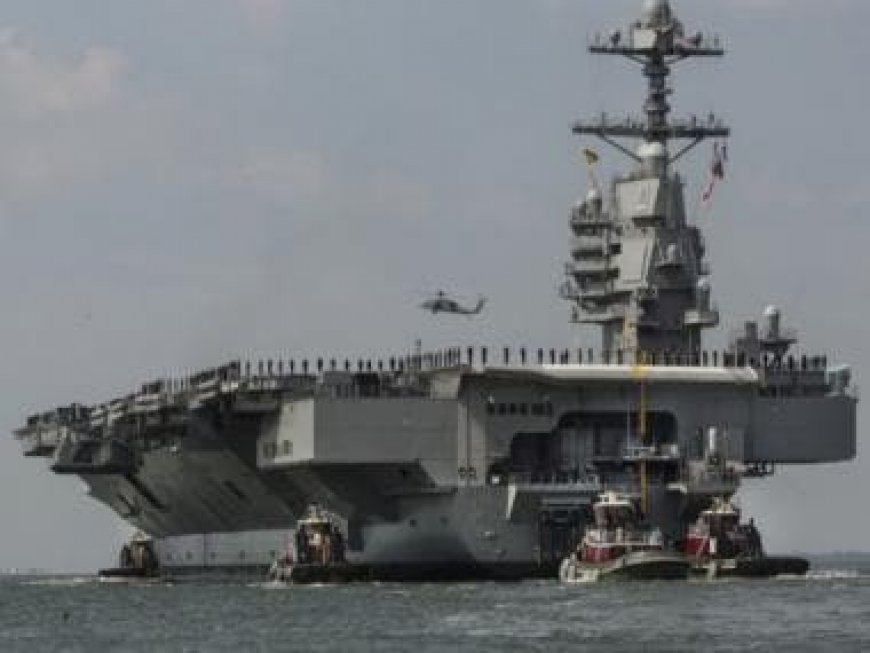China tests new hypersonic missile to attack US Navy, destroys aircraft carrier in simulation drills6
China tests new hypersonic missile to attack US Navy, destroys aircraft carrier in simulation drills6

The most fearsome aircraft carrier group of the United States, which was previously thought to be immune to conventional weapons, may reportedly be “destroyed with certainty” by a certain number of hypersonic strikes, according to a recent set of war game simulations conducted by Chinese military planners.
The Chinese military planners have come to a conclusion on the Gerald R. Ford aircraft carrier and its supporting fleet that will be no doubt disturbing for the US Navy, according to a rare published source.
According to them, using hypersonic missiles could theoretically destroy the carrier and all of its auxiliary equipment “with certainty,” as SCMP stated.
In a report published in the Chinese-language Journal of Test and Measurement Technology in May, the results of a war game simulation that primarily focused on hypersonic strikes on a US carrier group were made public for the first time.
According to the article, Chinese forces used a barrage of 24 hypersonic anti-ship missiles to successfully sink the USS Gerald R. Ford carrier fleet in a series of more than 20 furious fights that were simulated on a platform used by China’s military – the People’s Liberation Army (PLA).
In accordance with the simulation’s depiction, despite repeated warnings, US ships continued to approach a Chinese-claimed island in the South China Sea.
The results of the wargame showed that almost all of the US surface vessels were seriously damaged by the onslaught and eventually sank. In the scenario, two hypersonic anti-ship missile models were fired, some of them coming from the distant Gobi Desert.
The report claimed that the Chinese military showcased remarkable prowess with their sophisticated launch strategy, employing a complex three-wave attack to outsmart the US carrier group’s formidable defense systems.
Six surface ships that were meticulously chosen for their cutting-edge technology and unmatched strength made up the US fleet in the war scenario. The CVN-78 Gerald R. Ford served as the group’s flagship. It was joined by the CG56 San Jacinto of the Ticonderoga class and four DDG-103 Arleigh Burke class Flight IIA guided missile destroyers.
Modern features on the 2017-commissioned Ford-class carrier include an electromagnetic launch system, cutting-edge radar, and electronic warfare systems.
The cruisers and destroyers in the carrier group were also outfitted with cutting-edge defences and armaments, including radar systems that could track and detect several targets at once. The RIM-161E SM-3, a missile designed to intercept ballistic missiles, was one of 264 missiles in the carrier group’s armament of air defence weapons.
In the simulation, the Chinese military was subject to a number of restrictions, including restricted use of surveillance satellites and a finite number of hypersonic missiles. The war game sought to provide a realistic evaluation while adhering to the maxim of “lenience with the enemy and strictness with oneself.”
According to reports, the two anti-ship missile variants used by the Chinese side have exceptional capabilities, being able to cruise at great heights and achieving an amazing top speed of Mach 11. Surprisingly, with just two hits, either model could destroy a carrier or major cruiser.
The study also found that one device had an 80 percent success rate and an operable range of 2,000 kilometres (1,240 miles). The other Chinese model, in comparison, had a 90 percent success rate with a range that was double.
The actual names of the hypersonic missiles used in the simulation are not included in the article, though. It only focuses on the two models used by the Chinese side and their performance traits.
The PLA detected the US carrier group during the simulation using its sea-based surveillance network. They simultaneously fired eight less-reliable hypersonic missiles from southern and central China.
The strike depleted the SM-3 munitions on board the US fleet, albeit some were intercepted. In response, the carrier, destroyers, and cruiser were the targets of eight more precise hypersonic missile launches by the PLA from northern and western China, according to the report.
Four ships from the US side escaped the attack, primarily destroyers because of their weak defence capabilities. Enemy radar was jammed by electronic warfare devices, and incoming missiles were misdirected by chaff and flare dispensers.
The Chinese military carried out a “mop-up” operation with six less precise hypersonic missiles after the PLA verified the status and positions of the remaining targets.
The carrier group was destroyed by the three-wave attack on average when the simulation was run numerous times, which led to the destruction of 5.6 out of every six surface vessels. Prioritising targets and using lure techniques were stressed in order to maximise efficiency and save ammo.
However, the South China Sea-focused war game simulation suggests that this area might end up being a flashpoint for warfare between Chinese and US naval troops.
The fact that these two troops have previously engaged in escalating combat in the area only serves to highlight how important the results of the war game simulation are.
Wargame simulations are useful for providing insights, but they cannot take the place of actual testing and evaluation.
The reasons for China’s dissemination of the outcomes of the war game are still unknown. Additionally, it is impossible to independently verify the data used in the war games.
However, if the information used in the war game simulation on Chinese hypersonic missiles dramatically differs from reality, it could degrade the simulation’s accuracy and lead to false conclusions.
Read all the Latest News, Trending News, Cricket News, Bollywood News,
India News and Entertainment News here. Follow us on Facebook, Twitter and Instagram.
What's Your Reaction?


























































